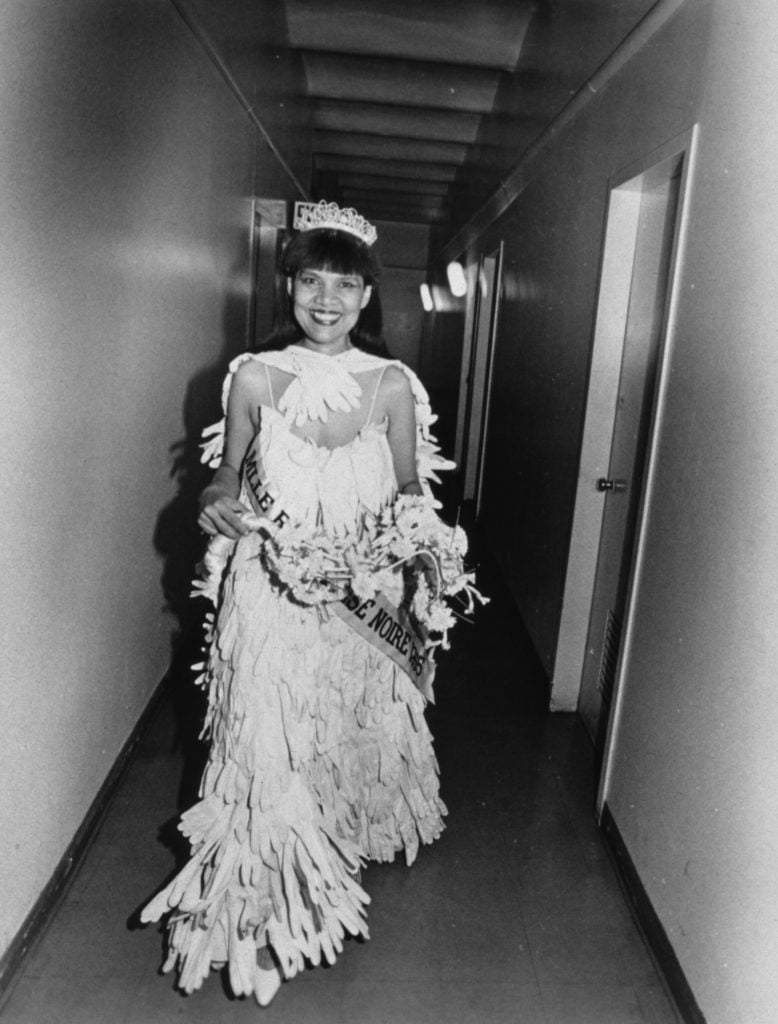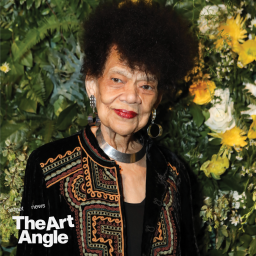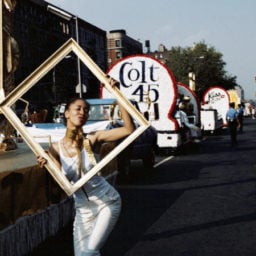This month, as the world inches its way toward spring (and, with it, hopefully a gradual return to normality), the Brooklyn Museum has opened a show, “Lorraine O’Grady: Both/And,” that provides valuable fodder for thought in the year ahead.
As the title suggests, it’s a career retrospective of the venerated performance and experimental artist Lorraine O’Grady, who for more than 40 years has created poetic, hard-to-classify works that probe questions of inclusion and identity in a way that has deeply informed a rising generation of artists. Admirers are also quick to point to the power of her writing, perhaps particularly Olympia’s Maid, her classic 1992 essay considering the flattening of Black female sexuality in art history.
Recently, chief art critic Ben Davis sat down with the artist (via Zoom) to discuss her career, how her upbringing in Boston’s Caribbean-American community shaped her art, and what it was like to go viral when the Biden administration paid homage to her work in a post-election ad.
A version of this conversation originally aired on The Art Angle Podcast, available in full here.
What do you think forms your artistic subjectivity? When you think about where you come from, what is important for people to know?
First of all, I’ve felt completely invisible in the culture as a whole.
And it wasn’t just that I felt I was personally invisible, but that everybody in my family, everybody that I knew, was invisible. In the beginning, I was just trying to make the invisible visible. It’s really been in the past 10, 15, 20 years or so that I began to focus on caste as the reason for the invisibility.
I was feeling that I was invisible not just to white people, but to Black people, and the purpose of this invisibility was the very purpose of segregation in itself, which was to prevent the entry of Black people into the middle class. Every time the middle-class appears, it has to be made invisible at some level or another.
So, for instance, we [Black people] have a great deal of the financial middle class in terms of the sports and entertainment industry, but we don’t have the sort of every day, lawyer/doctor middle-class. When I was a kid growing up, [I remember] realizing that all of the people that I knew were extremely accomplished, extremely well-educated.
This is in Boston?
Yes, so I began showing pictures of my sister’s 16th birthday party to show how that was celebrated; long gowns for the girls and suits for the boys and so forth. Looking at that picture, you could see how invisible everybody’s accomplishments were.
One of my sister’s girlfriends, her older brother [went on to become] the second black solicitor general of the United States. In my own family, my sisters helped set up the first school of social work in the country, but there would be no record of that or any of her other accomplishments. Her husband went to University of Pennsylvania dental school when he was 17, he graduated at 21!
It was possible for people to think somehow that when the Obamas were elected, these were the first Black middle class people that had ever existed in the face of the earth. It was so distorted, and that was personally hurtful.
It was pretty hard not to notice that wherever I went I was the only Black person, and when I entered the art world, it felt even more distorted because everything in the art world is a little bit more exaggerated than anywhere else.
The idea that there could be Black artists making interesting work was not something that ever actually occurred to anyone on the white side.
Then from the Black side, I felt that many of the artists that I saw were complicit with their own invisibility, by pretending somehow to be “street kids,” seeking credibility from the street. What middle-class person feels the need to do that?
You mean that art consumers are looking for a Black artist that represents what they perceive to be the Black condition, which is just this distorted view of things?
What I’m talking about as a people whose complexity has been totally effaced, totally reduced, and this is simply not truthful.
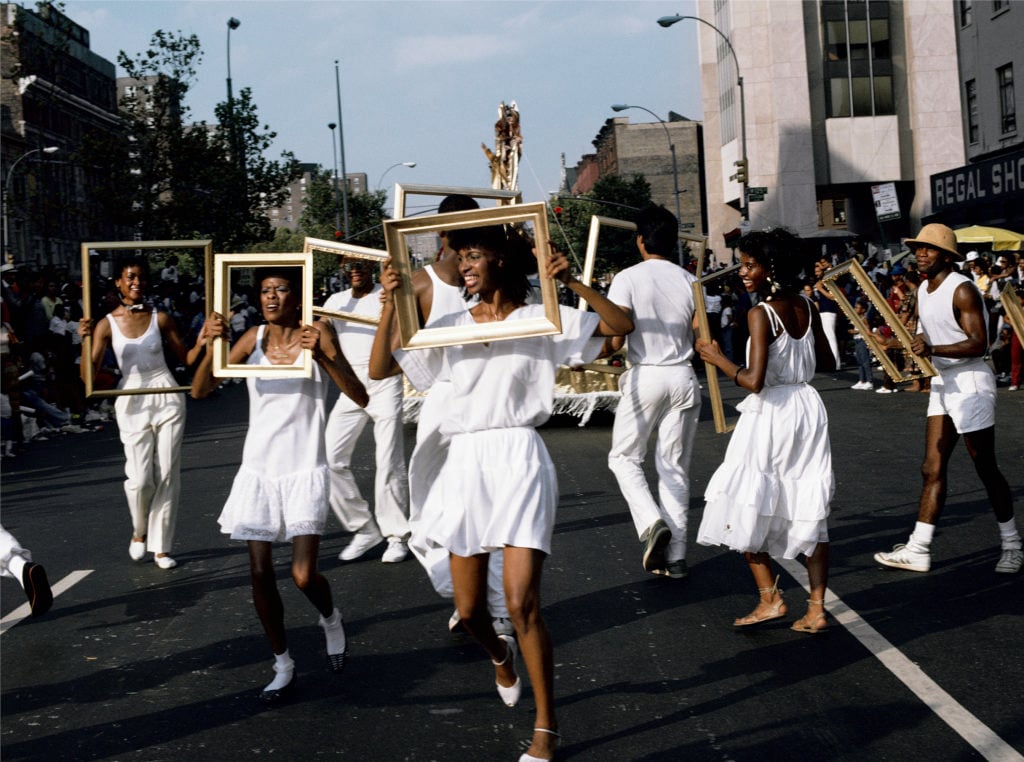
Lorraine O’Grady, Art Is (Troupe Front), 1983/2009. © 2018 Lorraine O’Grady/Artists Rights Society (ARS), New York. Courtesy Alexander Gray Associates, New York.
Do you have a particular creative method that you use? What’s the thread that you follow in making art?
Well, I do respond to the outside world as well as to my inner promptings. I am somebody who doesn’t make work without an audience. I’m a performer, and so I need an audience to be in dialogue with, and once that dialogue starts, then this spigot is on where idea after idea after idea starts flowing. When nobody pays attention, that can dry up a little bit, you know?
I want to ask you about your life between your childhood in Boston until the ’70s, when you enter the art world. You lived many different lives it seems.
I didn’t just become an artist in my mid-40s. I had been trying to become an artist since my mid-20s, not a visual artist, but a literary artist. I had gone to the Iowa Writers Workshop in my late 20s, early 30s, and I had been sort of running toward myself, but not finding myself, not being able to express myself at the level that I wanted to, because I just didn’t have the chops.
You worked for the government, you worked as a translator, you volunteered for Jesse Jackson, you worked as a rock-and-roll critic for the Village Voice. You really just took in a lot of different colors for your palette to paint with later.
They were all worlds that I felt comfortable in. That’s the advantage of having to fit in everywhere. I’m sure that most people who listen to rock music have things they want to say about it, but I was just able to say whatever I wanted to and get paid.
When you entered the art world, as I understand it, it was through the gallery Just Above Midtown, a Black art space. What drew you there?
The people. I had gone to the opening of this Afro American abstraction show at PS1, in the days when they used to advertise openings in the Village Voice. I found myself really, for the first time, surrounded by people that I hadn’t realized existed in as large a number. This was a whole opening filled with Black people who were all beautiful, smart, artistically dressed.
I knew that Just Above Midtown was where I could hook up with them and so I just sort of appeared there and did the usual kind of bourgeois thing, which was that I volunteered. You know, after about three weeks, I realized I could write the stuff that was in the envelopes I was stuffing.
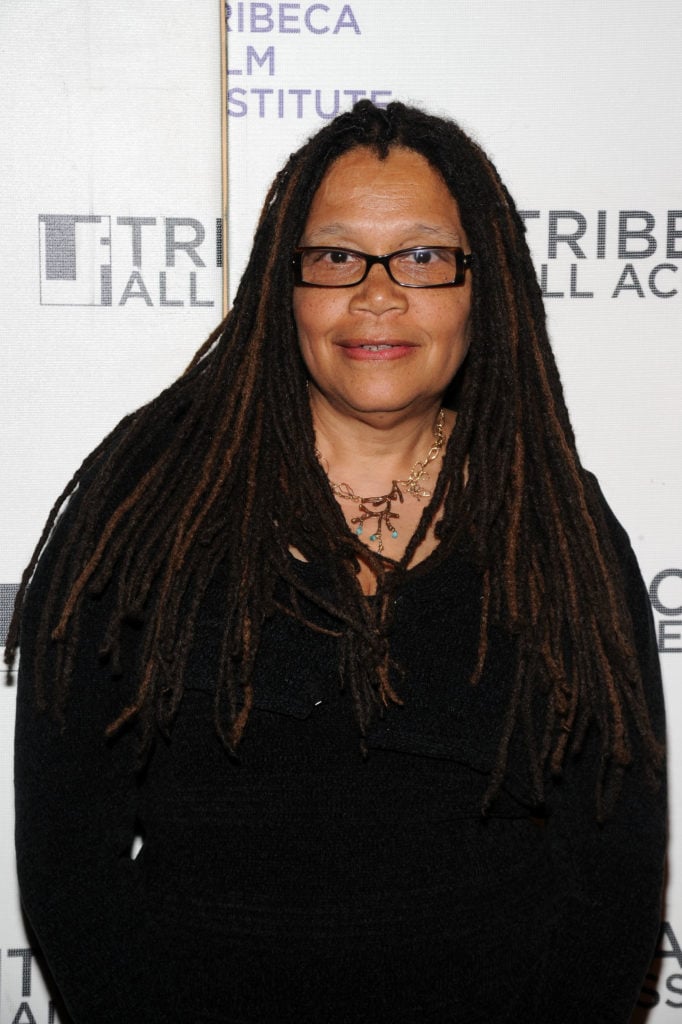
Linda Goode Bryant at Tribeca Film Festival. Photo by Bryan Bedder/Getty Images for Tribeca Film Festival.
They really lucked out, having a rock-and-roll critic stuffing the press releases for the art gallery.
Exactly. They had a new space on Franklin Street and I tried to get people to come to the opening show. So I made a phone call to the New Yorker, and in those days someone actually answered the phone. I was talking about the show and how great I thought it was going to be and I said, it’s called “Outlaw Aesthetics.”
And she said, “Oh, they always like to put titles on their shows, don’t they?” I went cold when I heard her say that—it’s true that at that time, most shows would be called the artist’s name and dated paintings or sculptures or whatever, but Linda Goode Bryant was very creative and she put titles on the shows. Of course, everybody puts a title on their show now, but then it seemed unsophisticated in some way.
It was very typical to me of the kind of lack of responsiveness to what should have been responded to. When you think about the artists that were there, it was me, there was David Hammons, Senga Nengudi, Maren Hassinger—all of these people who were really superb artists, but they knew that they were not going to get shown at a certain point, and so they made work for each other.
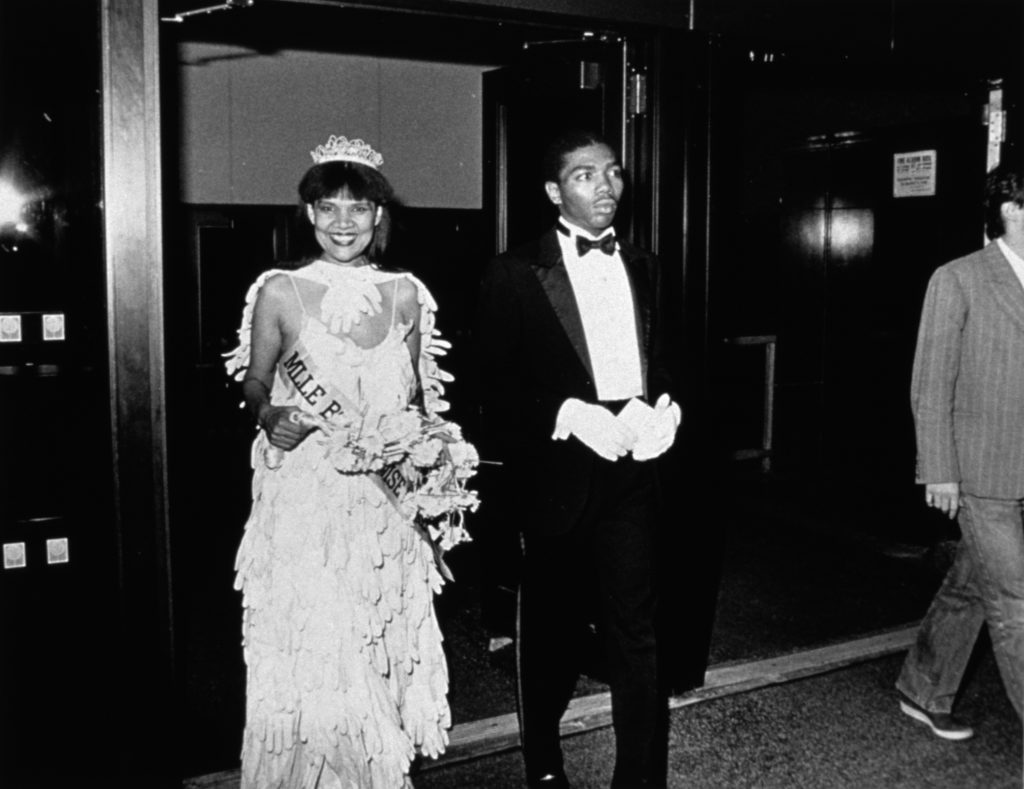
Lorraine O’Grady, Untitled (Mlle Bourgoise Noire and her Master of Ceremonies enter the New Museum (1980-83/2009). © Lorraine O’Grady/Artists Rights Society (ARS) NY. Courtesy Alexander Gray Associates, NY.
One of your most famous works of art is a performance of this character that you adopted of “Mademoiselle Bourgeoise Noire,” that was almost like an intervention into that Just Above Midtown art scene. How did you come up with the idea and how did people react?
Well, I had liked the opening night of “Afro-American Abstraction,” but I hadn’t liked the work so much. It felt very tame in comparison to what I thought abstract art could do. I was teaching at SVA [the School of Visual Arts] at the time, and one day I was walking home and I just had this vision of myself where I was covered in white gloves and I said, “Oh, that’s what that was all about!” That work [in “Afro-American Abstraction”] was abstraction with white gloves on.
And so I made this piece to critique that, and of course I never do anything that’s only about one thing, and so it was also a critique of bourgeois-ness. It never occurred to me that I would put on a gown and a cape made of 180 pairs of white gloves, beat myself with a whip, and have people think I was glorifying the Black middle class!
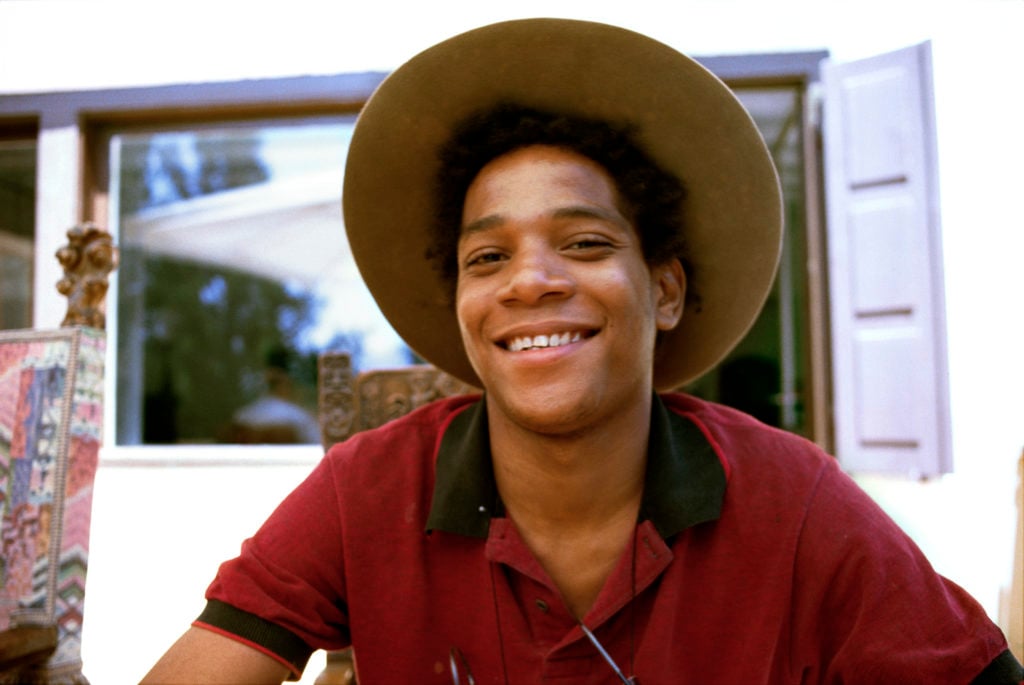
Jean-Michel Basquiat. Photo: Lee Jaffe.
Right. And I think some people do have that impression, and that’s because they flatten out the idea of a Black art scene and they don’t think about the debates within that space.
Exactly. The complexity is completely flattened. It’s not just that they are making us invisible, we’re sort of making our own selves invisible that way. It’s interesting because I’ve written about Jean-Michel Basquiat, and I really connected to him behind all of this.
People actually believe these ridiculous myths about him being locked up in the basement of Annina Nosei’s gallery as if he were some primitive, just out of the jungle person, whereas in reality, there could not have been anyone who was more bourgeois than he was.
The ability to perceive reality on the part of those outside the group was nil. I have to say that one thing I really respected Jean-Michel for a lot was that he never played that game of being a street kid, even though he had lived on the streets. He was not a street child after all, he’d gone to Saint Ann’s [an elite private school in Brooklyn].
He was going to the Brooklyn Museum when he was a kid.
He wasn’t from the streets. He may have been able to live on the streets, but what he was was a Black Bourgeois Bohemian.
Which is just sort of an invisible category, I think.
He had all of the Black bourgeois bohemian traits. Even if he took drugs, he was taking it from that point of view.
You have this big show now [at the Brooklyn Museum], but you also have this new collection of writing that’s just come out called Writing in Space. I wanted to ask you about an essay from 1993 called “A Day at the Races,” about your encounter with Basquiat and your impressions of him and what his story meant to you. There’s this line that I always think of, particularly now, when there’s all this overheated speculation on the work of artists of color. You say:
I knew the art world was about to eat Basquiat up and before it did, I hoped to connect him to Black artists who, picked up in the sixties and then dropped, could give him perspective on its mores in a way that his graffiti friends could not.
What lessons do you take away from his story and what lessons have you picked up yourself that are relevant to artists trying to navigate this terrain today?
He was alone really at that time, but it would be very hard now for something like that to happen, because there is a large population now of Black artists, all of whom are highly educated.
I don’t think that comparing his situation to the situation today would be fair to either side. He was able to think of the Bohemian self-destruction as a sort of glamorous way to go, whereas I don’t think you would find that [way of thinking] very much among Black artists now.
There’s not much of a Bohemia now, as far as I can tell—it’s a very professional world.
I don’t think that you would find very many Black artists who would think that taking heroin was cool—there’s too much knowledge now.
At the simplest political level, what caste does is it makes the white proletariat romantic. The most backward white person from the hills of Appalachia can feel that they are better than any Black person, including President Obama—the mob who stormed the Capitol was filled with people like that. And it’s not ridiculous because in fact, whiteness, as [artist] Adrian Piper used to point out, has monetary value. So the question is: How does that mindset apply to the art world?
I am not sure. Nothing is simple. Nothing has just one answer. For me, the question is, have the Black artists, even the most successful, been able to cross over into that place where white art students want to be them? Or are they still safely bracketed and separate no matter how successful they get?
In the last couple years, there’s been this tremendous hunger for Black artists. It is really long overdue, but there’s all these pitfalls and dynamics. I don’t think it totally escapes the dilemmas of caste that you’re talking about. It’s a complex phenomenon—there’s very cynical interest in Black artists, there’s very sincere interest in representation, and there are people trying to navigate that in all kinds of different ways.
Maybe we are making breakthroughs, but maybe we’re just sort of making breakthroughs that allow people to pat themselves on the back.
I think when a museum is asked to have more representation, often they really are just looking for a Black artist, and that means that they end up looking to the names they know best. Unless you bring in people with different positions and relationships to economic privilege, educational privilege, and so on, then—even as you’re bringing people in—you end up replicating division between people.
There’s a whole world of human life, including my own human life, that I feel the need to understand for myself. I don’t feel the need to constantly explain myself to them. I need to explain it to me. All of it—sex, love, and hate and all of the rest of it.
Race is something that feels more and more like a real effort to explore. One does it out of a sense of responsibility, but not out of a sense of need, because one already feels one understands as much as one is ever going to understand, or as much as one needs to understand. I’ve tried to get to the point where I can engage in as much self exploration as possible without having to foreclose my options as an artist in order to wage battles that are already clear.
I think the dilemmas are not mine, the dilemmas are someone else’s: white people’s. And they’re the ones who need to start solving it.
There’s a lot of things that I want to explore that have been diverted by this political requirement. I have some work that I’m really very proud of, even though it’s not necessarily the most finished, like Rivers, First Draft (1982), the piece in Central Park, that was just about me dealing with myself. That’s the kind of work that if I don’t get a chance to do it now, I really will have felt that they won somehow.
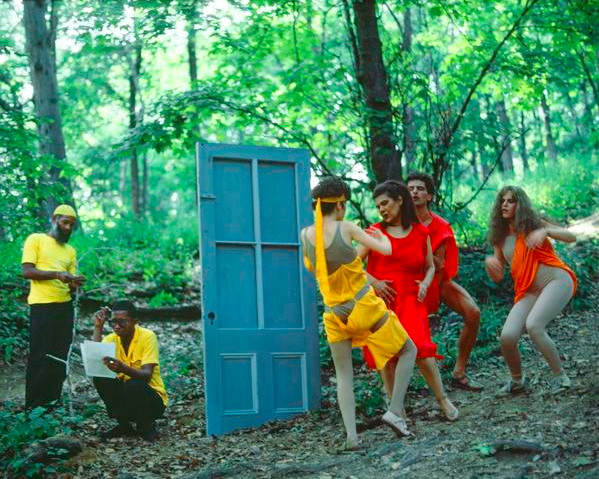
Lorraine O’Grady, Rivers, First Draft: The Debauchees intersect the Woman in Red, and the rape begins (1982/2015). Image: Courtesy Alexander Gray and Associates
I want to talk a little bit about activism in the art world. I was reading Dada Meets Mama, this 1992 essay on the Women’s Action Coalition, which was an artist-founded feminist organization begun in New York in reaction to the Clarence Thomas hearings. How has that kind of organizing behind the scenes been important to you?
I had become a single-issue feminist for various reasons. I was very much into reproductive rights, and I would say that in the ’70s, reproductive rights were not as supported by Black feminists as by white feminists for whom this was a primary battle.
And I always felt that if I wanted to get what I needed, I would have to make allies. I did do various forms of feminism, not just WAC, and it always did seem to come to the point where it looked as if I and other women of color were charged with bearing difference, whereas white women were free of difference. They were normative, and that did put a limit on how much one could actually accomplish politically, I think.
Yet I’ve made tremendously wonderful friends. I still have many of them, and so that’s the complexity of it—if you get into a world like that, friendship has an important role to play.
You’re someone who had a big comeback in a way, in the last 15 years or so, you know—
Comeback? I haven’t ever been there! I would have to say this is my first coming out, you know?
You were involved in a very important show called “WACK! Art and the Feminist Revolution” in 2009, that was a gathering of feminist art that Connie Butler partly curated, and she had known you from the Women’s Action Coalition, is that right?
Yeah. I’ve had moments of success, I can’t say that I haven’t over the years, but I think this is the first time there’s been success with a greater degree of understanding. So it feels more real in ways, and more sustainable.
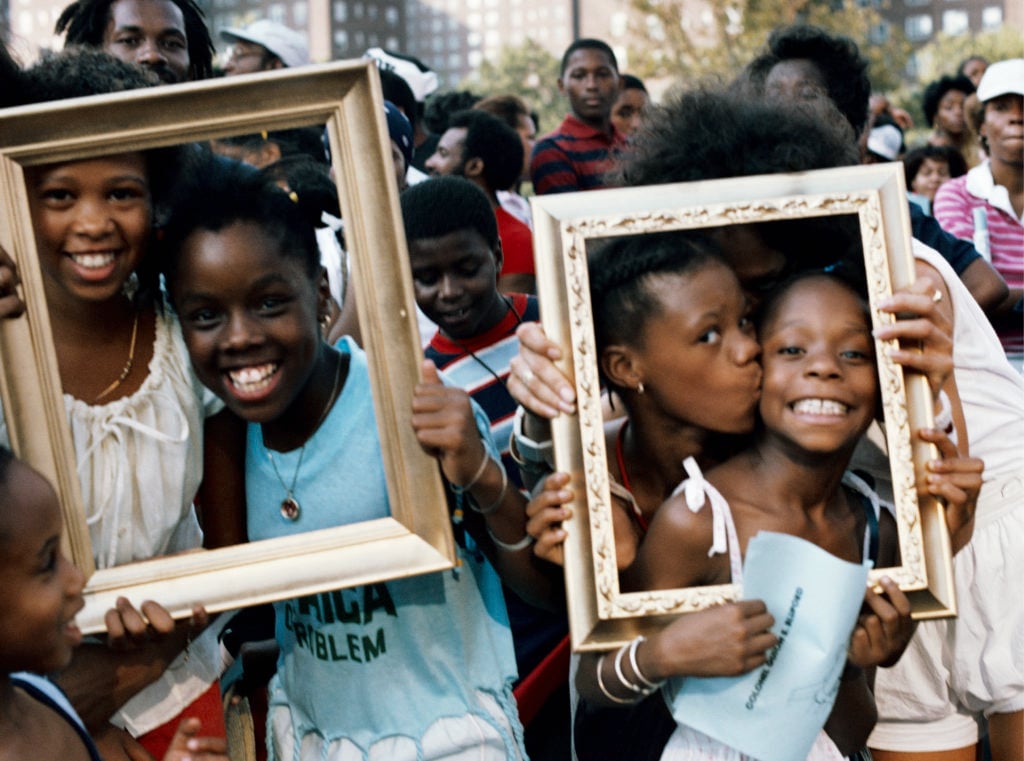
Lorraine O’Grady, Art Is (Girlfriends Times Two), (1983/2009). Courtesy of the artist and Alexander Gray Associates, New York.
Well, one of your most famous works is art is from 1983, which was this performance you did at the Harlem Day Parade, and people might know it now because there was an homage to it by the Biden-Harris campaign when they won.
That was kind of an amazing experience. You know, there were 40 million views on Twitter the first day.
In the performance, Art Is.., you took out a float in the parade and you had these picture frames that people in the audience could put around themselves.
We had a very large frame, a nine by 15-foot empty frame, and it was framing the cityscape, the landscape of these people’s lives. I think that’s what appealed to the Biden campaign, that they could show people in their landscape.
They were originally going to do almost an imitation of what I had done in Harlem, but then it became clear that they could do something much larger. The whole purpose of Art Is… was to show that there was a very large audience for art that was not being included either as audience or as creator. I think the Biden-Harris video was able to make it a larger point, doing it in the way that they did, so I was thrilled with how it turned out.
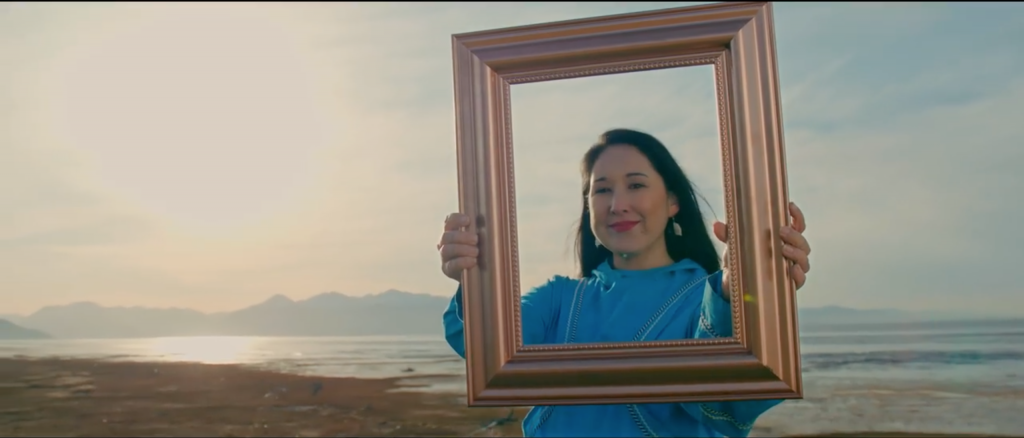
Screen shot from Joe Biden’s victory video via Instagram.
Did you get any feedback? Did people who’d never known your work before come to know you through it? 40 million people is a lot of people.
It was very funny though. I said, this is amazing, and then the next day there were maybe 20 million, and then the day after that, it was just normal. How fleeting is fame!
What do you hope people take away from the show? What do you hope they see?
The complexity. I’m not somebody who is digging down deep to find an ultimate truth, just simply trying to make as many of my truths as visible as possible since they’ve been made invisible.
What do you think will be the biggest surprise?
There’s a lot of work that they haven’t seen, and I think they really haven’t seen the work if they haven’t seen the work together. That’s what’s so amazing about this moment: It’s the first retrospective of a long career that hasn’t had enough exposure. So I think that it’s going to be the first time that people are able to see who I am as an artist.
